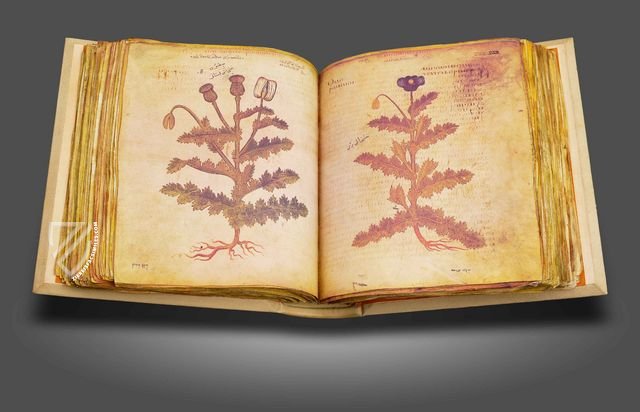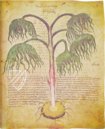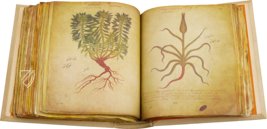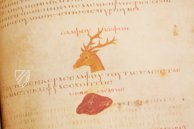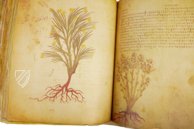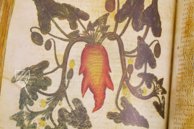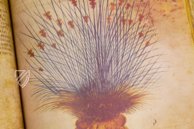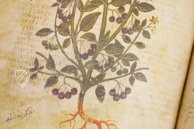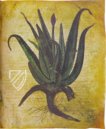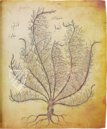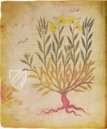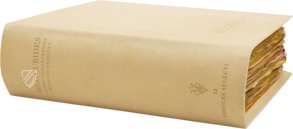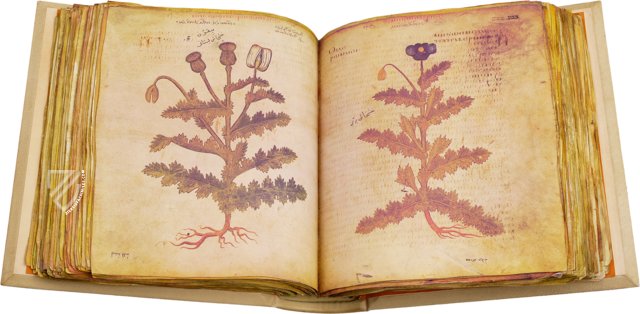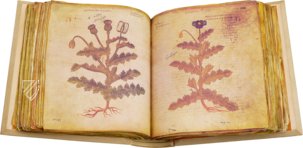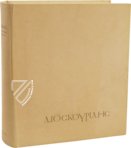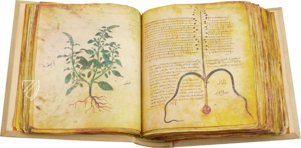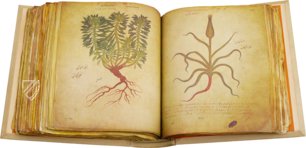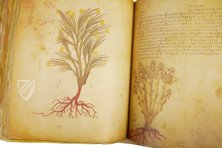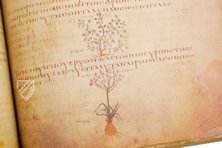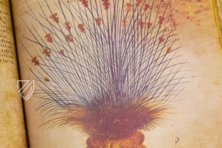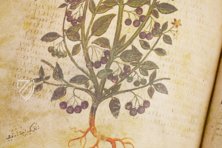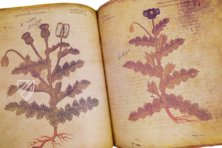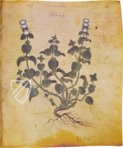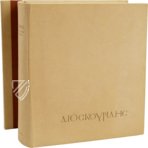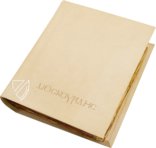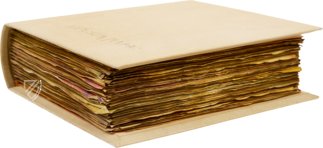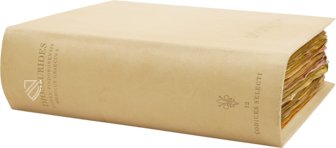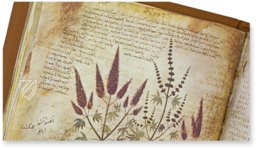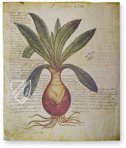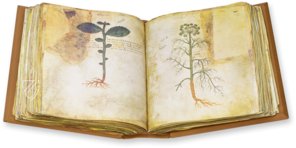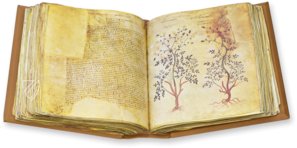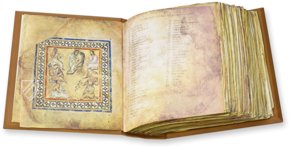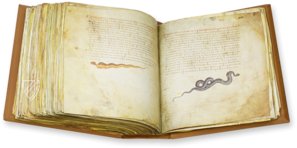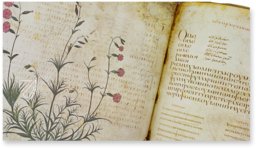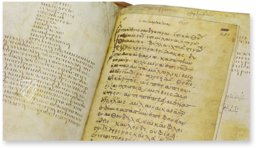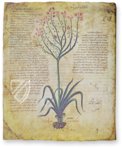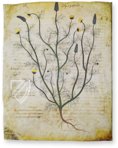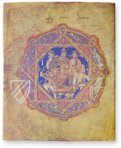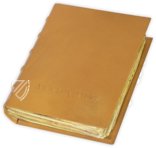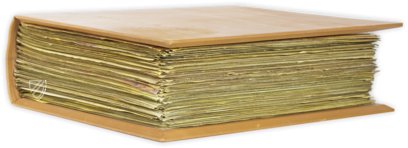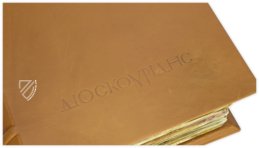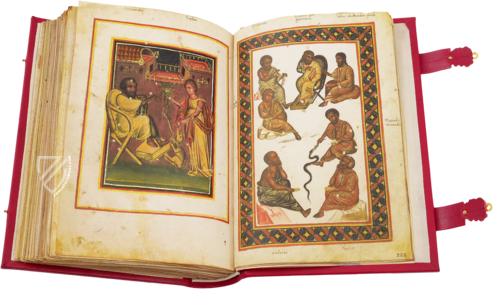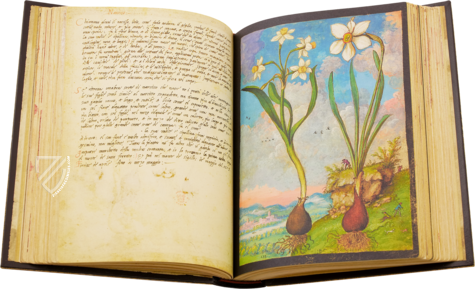Vienna Dioscorides
(7,000€ - 10,000€)
One of the most precious late classical illuminated manuscripts is an herbarium produced in Constantinople at the beginning of the 6th century, which is called the Vienna Dioscorides after its current place of conservation. This codex describes numerous efficacious herbs as well as poisonous animals and birds; it is appended by transcriptions of four classical scientific works. It is illustrated by 392 full-page miniatures and 87 smaller miniatures embedded in the text, the majority of which are dedicated to plants, with 66 devoted to poisonous animals and 47 of which illustrate various bird species. These miniatures represent excellent copies of late Hellenistic-Roman models and are priceless not least because the antique originals have been lost. With all of this in mind, it is no wonder that the manuscript was declared a UNESCO Memory of the World Document in 1998.
Vienna Dioscorides
Like the fascinating images of human beings and animals contained in the book, the depictions of plants bear testimony to the great art of illumination in the Byzantine Empire. In line with the textual tradition – the herbarium of the Greek physician Pedanius Dioscorides (1st century) including insertions from writings of other authors and a number of significant appendices – the Vienna Dioscorides has provided a virtually inexhaustible source for the history of classical sciences and early Byzantine culture. The codex had an enormous influence for several centuries and became the ancestor of numerous herbal manuscripts of the Middle Ages, down to the beginning of the modern age. It bears traces of continuous use by Greek, Latin, Turkish, Oriental, and Jewish physicians, thus proving an ongoing esteem for classical pharmacology. With the increasing interest in the effects of medicinal herbs in modern times, the Vienna Dioscorides is gaining ever-wider recognition, and was awarded the status of UNESCO Memory of the World Document in 1998.
Testimony to Byzantine Illumination
The dedication picture introducing the manuscript allows it to be dated to ca. 512 and located in a workshop in Constantinople. It shows the Byzantine princess Juliana Anikia, endower of a church in the quarter of Honoratae; she is being presented the precious codex as a gift from the citizens of Constantinople. This collective manuscript not only referred to the most diverse sources but also provided a résumé of all relevant findings of Greek research in the field of pharmacy and applied botany. The Vienna Dioscorides therefore remains an all-encompassing reference work for specialists in medicine and pharmacology.
Invaluable Source for the Sciences, Illumination, and Philology
The manuscript largely consists of a copy of the herbal by the physician and botanist Pedanius Dioscorides, which is arranged in alphabetical order. It describes 383 medicinal herbs in Greek majuscule, a script often referred to by researchers as Bible majuscule. We also find transcriptions in a later minuscule as the old majuscule script became increasingly difficult to read. In a highly sophisticated didactic approach, the descriptive text is accompanied with pictorial representations of the plants. Most of these illustrations cover a whole page and are executed in opaque color painting. Together with 66 images of poisonous animals and 47 illustrations of birds, they represent excellent copies of late Hellenistic-Roman models and are priceless not least because the antique originals have been lost. The herbarium covers the main part of the book and is followed by several appendices, among them an anonymous poem on the effects of plants dedicated to the Gods (carmen de viribus herbarum) and four transcriptions of classical scientific works. These are the transcription of Eutecnios on the Theriaca by Nicandros of Colophon containing illustrations of plants and wild animals (snakes, scorpions, spiders), the transcription of the same author on the Alexipharmaca by Nicandros, an anonymous transcription on the Halieutica by Oppianos, and an anonymous transcription on the Ornithiaca by Dionysos of Philadelphia including numerous depictions of birds, which have proved important in the history of zoological illustration. The book concludes with some small fragments of a Menaion, a liturgical service manuscript including the lives of saints, which goes beyond the scope of its contents.
Codicology
- Alternative Titles
- Wiener Dioskurides
Pedacio Dioscorides Anazarbeo, De Materia Medica
Dioscurides Constantinopolitanus
Codex Vindobonensis
Juliana Anicia Codex - Size / Format
- 984 pages / 38.0 × 31.0 cm
- Origin
- Turkey
- Date
- Ca. 512
- Epochs
- Style
- Language
- Illustrations
- 392 full-page pictures and 87 pictures within the text
- Patron
- Anicia Iuliana
- Previous Owners
- Moses Hamon
Maximilian II
Vienna Dioscorides
Agrimonia
Labelled here in Greek as ἀργεμώνη, genus Agrimonia consists of about a dozen perennial herbaceous flowering plants characterized by its tiny but brightly colored flowers arranged on unbranched spikes. According to Dioscorides, the plant can be used to ease sore gums and throats, stop bleeding, and treat ailments of the stomach, liver, and gallbladder. It can also be used to create foot baths for tired feet, treat wounds, and the Anglo-Saxons used it to enhance male sexual performance.

Vienna Dioscorides
Dedication Miniature
The Vienna Dioscorides is a fundamental work of herbal medicine and a fine testimony of the Byzantine art of illumination in Late Antiquity. We are able to date the completion of this manuscript to the year 512 and trace it to a workshop in Constantinople thanks to the dedication miniature. It shows the patron of the manuscript, Princess Julia Anikia, being presented with the codex by the citizens of Constantinople.
Princess Julia is receiving this gift as an act of gratitude for her support of the Theotokos Church in the Honoratae quarter. Eight smaller scenes surrounding her portrait depict her support of the arts and architecture of the imperial capital. The eight pointed star that makes up the frame is depicted as though it is woven like a rope.
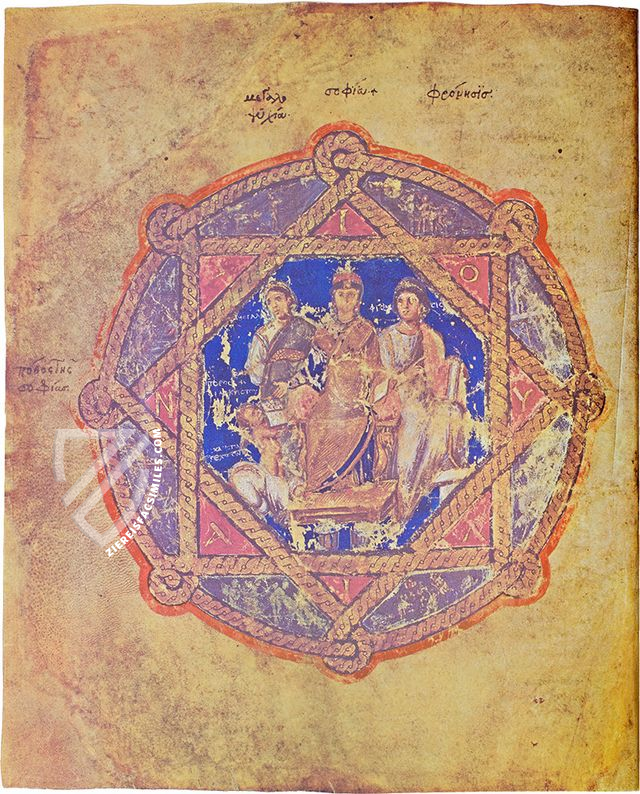
#1 Der Wiener Dioskurides
Language: German
(7,000€ - 10,000€)
#2 De Materia Medica by Pedacio Dioscorides
Language: Spanish
(over 10,000€)
- Treatises / Secular Books
- Apocalypses / Beatus
- Astronomy / Astrology
- Bestiaries
- Bibles / Gospels
- Chronicles / History / Law
- Geography / Maps
- Saints' Lives
- Islam / Oriental
- Judaism / Hebrew
- Single Leaf Collections
- Leonardo da Vinci
- Literature / Poetry
- Liturgical Manuscripts
- Medicine / Botany / Alchemy
- Music
- Mythology / Prophecies
- Psalters
- Other Religious Books
- Games / Hunting
- Private Devotion Books
- Other Genres
- Afghanistan
- Armenia
- Austria
- Belgium
- Belize
- Bosnia and Herzegovina
- China
- Colombia
- Costa Rica
- Croatia
- Cyprus
- Czech Republic
- Denmark
- Egypt
- El Salvador
- Ethiopia
- France
- Germany
- Greece
- Guatemala
- Honduras
- Hungary
- India
- Iran
- Iraq
- Israel
- Italy
- Japan
- Jordan
- Kazakhstan
- Kyrgyzstan
- Lebanon
- Liechtenstein
- Luxembourg
- Mexico
- Morocco
- Netherlands
- Palestine
- Panama
- Peru
- Poland
- Portugal
- Romania
- Russia
- Serbia
- Spain
- Sri Lanka
- Sweden
- Switzerland
- Syria
- Tajikistan
- Turkey
- Turkmenistan
- Ukraine
- United Kingdom
- United States
- Uzbekistan
- Vatican City
- A. Oosthoek, van Holkema & Warendorf
- Aboca Museum
- Ajuntament de Valencia
- Akademie Verlag
- Akademische Druck- u. Verlagsanstalt (ADEVA)
- Aldo Ausilio Editore - Bottega d’Erasmo
- Alecto Historical Editions
- Alkuin Verlag
- Almqvist & Wiksell
- Amilcare Pizzi
- Andreas & Andreas Verlagsbuchhandlung
- Archa 90
- Archiv Verlag
- Archivi Edizioni
- Arnold Verlag
- ARS
- Ars Magna
- ArtCodex
- AyN Ediciones
- Azimuth Editions
- Badenia Verlag
- Bärenreiter-Verlag
- Belser Verlag
- Belser Verlag / WK Wertkontor
- Benziger Verlag
- Bernardinum Wydawnictwo
- BiblioGemma
- Biblioteca Apostolica Vaticana (Vaticanstadt, Vaticanstadt)
- Bibliotheca Palatina Faksimile Verlag
- Bibliotheca Rara
- Boydell & Brewer
- Bramante Edizioni
- Bredius Genootschap
- Brepols Publishers
- British Library
- C. Weckesser
- Caixa Catalunya
- Canesi
- CAPSA, Ars Scriptoria
- Caratzas Brothers, Publishers
- Carus Verlag
- Casamassima Libri
- Centrum Cartographie Verlag GmbH
- Chavane Verlag
- Christian Brandstätter Verlag
- Circulo Cientifico
- Club Bibliófilo Versol
- Club du Livre
- CM Editores
- Collegium Graphicum
- Collezione Apocrifa Da Vinci
- Comissão Nacional para as Comemorações dos Descobrimentos Portugueses
- Coron Verlag
- Corvina
- CTHS
- D. S. Brewer
- Damon
- De Agostini/UTET
- De Nederlandsche Boekhandel
- De Schutter
- Deuschle & Stemmle
- Deutscher Verlag für Kunstwissenschaft
- DIAMM
- Droz
- E. Schreiber Graphische Kunstanstalten
- Ediciones Boreal
- Ediciones Grial
- Ediclube
- Edições Inapa
- Edilan
- Editalia
- Edition Deuschle
- Edition Georg Popp
- Edition Leipzig
- Edition Libri Illustri
- Editiones Reales Sitios S. L.
- Éditions de l'Oiseau Lyre
- Editions Medicina Rara
- Editorial Casariego
- Editorial Mintzoa
- Editrice Antenore
- Editrice Velar
- Edizioni Edison
- Egeria, S.L.
- Eikon Editores
- Electa
- Emery Walker Limited
- Enciclopèdia Catalana
- Eos-Verlag
- Ephesus Publishing
- Ernst Battenberg
- Eugrammia Press
- Extraordinary Editions
- Fackelverlag
- Facsimila Art & Edition
- Facsimile Editions Ltd.
- Facsimilia Art & Edition Ebert KG
- Faksimile Verlag
- Feuermann Verlag
- Folger Shakespeare Library
- Franco Cosimo Panini Editore
- Friedrich Wittig Verlag
- Fundación Hullera Vasco-Leonesa
- G. Braziller
- Gabriele Mazzotta Editore
- Gebr. Mann Verlag
- Gesellschaft für graphische Industrie
- Getty Research Institute
- Giovanni Domenico de Rossi
- Giunti Editore
- Graffiti
- Grafica European Center of Fine Arts
- Guido Pressler
- Guillermo Blazquez
- Gustav Kiepenheuer
- H. N. Abrams
- Harrassowitz
- Harvard University Press
- Helikon
- Hendrickson Publishers
- Henning Oppermann
- Herder Verlag
- Hes & De Graaf Publishers
- Hoepli
- Holbein-Verlag
- Houghton Library
- Hugo Schmidt Verlag
- Idion Verlag
- Il Bulino, edizioni d'arte
- ILte
- Imago
- Insel Verlag
- Insel-Verlag Anton Kippenberger
- Instituto de Estudios Altoaragoneses
- Instituto Nacional de Antropología e Historia
- Introligatornia Budnik Jerzy
- Istituto dell'Enciclopedia Italiana - Treccani
- Istituto Ellenico di Studi Bizantini e Postbizantini
- Istituto Geografico De Agostini
- Istituto Poligrafico e Zecca dello Stato
- Italarte Art Establishments
- Jan Thorbecke Verlag
- Johnson Reprint Corporation
- Josef Stocker
- Josef Stocker-Schmid
- Jugoslavija
- Karl W. Hiersemann
- Kasper Straube
- Kaydeda Ediciones
- Kindler Verlag / Coron Verlag
- Kodansha International Ltd.
- Konrad Kölbl Verlag
- Kurt Wolff Verlag
- La Liberia dello Stato
- La Linea Editrice
- La Meta Editore
- Lambert Schneider
- Landeskreditbank Baden-Württemberg
- Leo S. Olschki
- Les Incunables
- Liber Artis
- Library of Congress
- Libreria Musicale Italiana
- Lichtdruck
- Lito Immagine Editore
- Lumen Artis
- Lund Humphries
- M. Moleiro Editor
- Maison des Sciences de l'homme et de la société de Poitiers
- Manuscriptum
- Martinus Nijhoff
- Maruzen-Yushodo Co. Ltd.
- MASA
- Massada Publishers
- McGraw-Hill
- Metropolitan Museum of Art
- Militos
- Millennium Liber
- Müller & Schindler
- Nahar - Stavit
- Nahar and Steimatzky
- National Library of Wales
- Neri Pozza
- Nova Charta
- Oceanum Verlag
- Odeon
- Orbis Mediaevalis
- Orbis Pictus
- Österreichische Staatsdruckerei
- Oxford University Press
- Pageant Books
- Parzellers Buchverlag
- Patrimonio Ediciones
- Pattloch Verlag
- PIAF
- Pieper Verlag
- Plon-Nourrit et cie
- Poligrafiche Bolis
- Presses Universitaires de Strasbourg
- Prestel Verlag
- Princeton University Press
- Prisma Verlag
- Priuli & Verlucca, editori
- Pro Sport Verlag
- Propyläen Verlag
- Pytheas Books
- Quaternio Verlag Luzern
- Reales Sitios
- Recht-Verlag
- Reichert Verlag
- Reichsdruckerei
- Reprint Verlag
- Riehn & Reusch
- Roberto Vattori Editore
- Rosenkilde and Bagger
- Roxburghe Club
- Salerno Editrice
- Saltellus Press
- Sandoz
- Sarajevo Svjetlost
- Schöck ArtPrint Kft.
- Schulsinger Brothers
- Scolar Press
- Scrinium
- Scripta Maneant
- Scriptorium
- Shazar
- Siloé, arte y bibliofilia
- SISMEL - Edizioni del Galluzzo
- Sociedad Mexicana de Antropología
- Société des Bibliophiles & Iconophiles de Belgique
- Soncin Publishing
- Sorli Ediciones
- Stainer and Bell
- Studer
- Styria Verlag
- Sumptibus Pragopress
- Szegedi Tudomànyegyetem
- Taberna Libraria
- Tarshish Books
- Taschen
- Tempus Libri
- Testimonio Compañía Editorial
- Thames and Hudson
- The Clear Vue Publishing Partnership Limited
- The Facsimile Codex
- The Folio Society
- The Marquess of Normanby
- The Richard III and Yorkist History Trust
- Tip.Le.Co
- TouchArt
- TREC Publishing House
- TRI Publishing Co.
- Trident Editore
- Tuliba Collection
- Typis Regiae Officinae Polygraphicae
- Union Verlag Berlin
- Universidad de Granada
- University of California Press
- University of Chicago Press
- Urs Graf
- Vallecchi
- Van Wijnen
- VCH, Acta Humaniora
- VDI Verlag
- VEB Deutscher Verlag für Musik
- Verlag Anton Pustet / Andreas Verlag
- Verlag Bibliophile Drucke Josef Stocker
- Verlag der Münchner Drucke
- Verlag für Regionalgeschichte
- Verlag Styria
- Vicent Garcia Editores
- W. Turnowski Ltd.
- W. Turnowsky
- Waanders Printers
- Wiener Mechitharisten-Congregation (Wien, Österreich)
- Wissenschaftliche Buchgesellschaft
- Wissenschaftliche Verlagsgesellschaft
- Wydawnictwo Dolnoslaskie
- Xuntanza Editorial
- Zakład Narodowy
- Zollikofer AG

